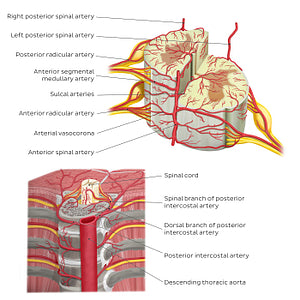Rebecca Betts
Arteries of the spinal cord (English)
Arteries of the spinal cord (English)
The spinal cord, its roots and nerves are supplied with arterial blood by longitudinal and segmental vessels. The longitudinal vessels are the single anterior spinal and paired posterior spinal arteries that arise, from the vertebral artery and terminate near the conus medullaris. The anterior spinal artery descends in the anterior median fissure and gives off the sulcal branches, which enter the substance of the spinal cord. The anterior spinal artery provides blood to the anterior two-thirds of the spinal cord, supplying the anterior and lateral gray column, central gray matter and anterior and lateral funiculus. The two posterior spinal arteries arise mainly from the vertebral artery, but they can also arise from the inferior cerebellar artery. The posterior spinal arteries descend in the two posterolateral sulci. It provides blood to the posterior third of the spinal cord, supplying the posterior gray column and posterior funiculus. The anterior and posterior spinal arteries form pial anastomoses called the arterial vasocorona, which encircles the spinal cord and supplies its lateral surface and the spinal meninges. Each segment of the spinal cord receives additional supply from the segmental vessels that arise from different sources depending on the region. These arteries pass through the intervertebral foramina into the vertebral column, where they split into the anterior and posterior radicular branches and pass along the ventral and dorsal roots. Most of the radicular branches are small and end their course in the nerve roots. However, some larger radicular branches give off the segmental medullary arteries that feed into the anterior and posterior spinal arteries.
Preço normal
$7.56 USD
Preço normal
Preço promocional
$7.56 USD
Preço unitário
por
Não foi possível carregar a disponibilidade de retirada.


#F5D123
#AD635B
#B31828
#62372F
#F4DC5E e #CDB1AC

